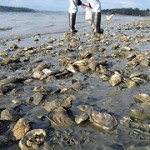In this blog series, we’ve explained how carbon dioxide pollution is making the oceans more acidic, demonstrated that it’s happening now, looked at which marine creatures are most at risk and talked to oyster growers, commercial fishermen, and Native American teenagers about their prospects if the ocean systems that support their businesses and culture collapse.
So what can we do about ocean acidification? Here are some of the key solutions:
- Reduce carbon emissions by developing policies that assign a cost to that pollution and encourage a shift away from fossil fuels and towards clean energy.
- Use existing laws—from local land use planning to building codes to the Clean Water Act—to curb pollutants that make the problem worse.
- Invest in research and monitoring to see how important marine species will be affected, inform fisheries and ocean management plans, and help seafood producers adapt.
Curb carbon emissions

The root cause of ocean acidification is carbon emissions. They’re the catalyst that makes seawater more acidic and removes carbonate ions from the ocean that vast numbers of species need to build shells and skeletons. Without that essential ingredient, economically important species such as oysters and ecologically important plankton at the bottom of the food chain will run into trouble.
Most people can take simple steps to reduce their own carbon footprints, from driving less to insulating their homes to hanging a clothesline in the back yard. But the most effective way to reduce carbon emissions on a meaningful scale is to assign a cost to those emissions. Under that scenario, a cement factory or coal plant that releases carbon dioxide would have to pay for the right to do so, and would have incentive to pollute less. Gasoline would cost more, spurring demand for more efficient cars, bike-friendly streets and convenient transit options. And putting a price on carbon pollution would generate revenue at a time when government coffers are distressingly bare.
There are different economic models for achieving those goals. The Regional Greenhouse Gas Initiative (RGGI) is a market-based approach to reduce greenhouse gas emissions from power plants in 10 Northeastern states. California, New Mexico and three Canadian provinces are actively working towards another regional cap and trade program that would cap and reduce carbon emissions over time, issue permits to polluters, and allow the market to figure out how to meet those limits. British Columbia in 2008 introduced a new graduated tax on carbon sources, which allowed the province to cut personal and corporate income taxes by an equal amount. So far, the carbon tax has saved BC residents and companies more than $850 million, and there are signs that it is generating energy savings.
Brad Warren, who works with commercial fishermen through the Sustainable Fisheries Partnership, points to other examples where we’ve successfully gotten the flow of harmful emissions under control, such as the sulfur dioxide trading program that has reduced acid rain.
These are not easy problems but they’re not as hard as they’re often made out to be. We’re going to have to become managers of things we didn’t feel like we had to manage. It’s really just an old school resource management problem. We’ve done it before, we can probably do it again. You can use taxes, carbon markets, implement other controls, energy efficiency, increased use of cleaner power. There are many tools, but no one I think can credibly argue that you can do it without some kind of carbon policy.
Passing legislation to reduce greenhouse gas emissions on a national scale in the US has proved difficult. But Brian Baird, the former US Congressman from southwest Washington who has served on science, marine, and energy committees and scuba dives in his spare time, thinks ocean acidification has the potential to reopen that conversation, precisely because it lacks some of the political baggage that now surrounds global warming.
The chemistry is simple and irrefutable—you can exhale carbon dioxide into a beaker of water and watch it turn more acidic, he said. People have an intuitive sense that acids can do bad things, like eat through a metal safe or disfigure a face. And ocean acidification speaks to new audiences—from Florida hotel owners who rely on healthy sport fishing populations to a landlocked teacher who spends her vacations snorkeling to the Northwest’s commercial fishing industry.
You have to some extent a more easily-grasped case to make. You can demonstrate it more readily and it has impacts that are more comprehensible. And in my experience the so-called skeptics and climate deniers have not marshalled a serious challenge to the ocean acidification argument yet.
Use existing laws
Even without new carbon policies, researchers have found a number of existing laws that state and local governments can use to start tackling ocean acidification right now. Coastal communities don’t need to wait for a binding international treaty to start addressing problems in their own back yards, said Ryan Kelly, a science, law and policy analyst for the Center for Ocean Solutions housed at Stanford University.
For every particular stretch of coastline, local conditions influence how soon corrosive water may show up and whether there are other pollution sources making the problem worse. In the Pacific Northwest, where researchers have found some of the most acidic water ever recorded, many coastlines experience seasonal upwelling that brings cold and acidic water up from the deep towards the surface, where it can pose a problem for a wide range of sea life. In places like Puget Sound, the pollution running off streets and yards and farms compounds the problem. As Kelly explains:
You know you have a narrow margin of error there. If you’re experiencing a lot of runoff, be it agricultural or from the impermeable surfaces from cities and towns, that’s just flowing freely to the water and you’ve got cold water coming onshore, that is a recipe for special damage from acidification.

One local solution is to reduce stormwater runoff that dumps nutrients into local waters. That pollution sucks up oxygen and leaves fish panting for air. It can also lower the pH of estuaries and make them more acidic, compounding whatever problems may be occurring because of ocean acidification. By encouraging developers to use less pavement or incorporating green drainage into street design or effectively regulating septic systems, cities can help keep nutrient pollution from entering waterways in the first place. Local jurisdictions can protect wetlands and control coastal erosion that dumps sediment into ocean habitat. And, more fundamentally, they can choose to invest in compact communities and transportation systems that move people efficiently and burn less fossil fuel.
Several federal laws also provide protection for marine waters and avenues to curb greenhouse gas emissions. One in particular—the Clean Water Act—is currently being tested as a way to address ocean acidification.
In 2009, the Center for Biological Diversity sued the EPA for failing to acknowledge that ocean acidification had already impaired waters off Washington State’s coast. In settling the suit, the EPA agreed to issue guidance on how ocean acidification should be considered under the Clean Water Act. The agency late last year put states on notice that they should list waters that are impaired because of ocean acidification where that information is available. The kicker, however, is that few states have meaningful data or an organized monitoring program for acidic or corrosive water.
If a water body were listed as impaired because of ocean acidification, states could have to come up with plans to reduce carbon dioxide emissions from cement plants and cars and other sources. But the EPA concluded it was premature to start developing carbon limits under the law until more information becomes available. Miyoko Sakashita, ocean program director for the Center for Biological Diversity, said the ruling has provided a good opportunity to begin educating water quality managers about their responsibilities and to address monitoring gaps.
It’s very important right now to begin to know what the baselines are and what our coastal ecosystems should look like. But there’s still very compelling science saying ocean acidification is happening here and now…so to the extent that we have that science and it looks like water quality standards are being violated, you’ll be hearing more from us.

Invest in monitoring and research
Accurately measuring pH in the ocean is a far cry from grade school chemistry experiments that use paper strips to test lemon juice and baking soda. It requires precise and expensive instrumentation. But a national investment in research and monitoring will be crucial to help scientists determine the extent of the problem and help seafood producers adapt.
With federal funding, oyster hatcheries in Oregon and Washington have been using monitoring systems that alert them to acidic water conditions that have correlated with massive die-offs of baby oysters. By helping them avoid water with high carbon dioxide levels, monitoring equipment and partnerships with university and federal researchers has saved their businesses from ruin. Scientists in Seattle and elsewhere are exposing commercially valuable creatures like crab, geoduck, and abalone to carbon-rich water in an attempt to anticipate future problems.
Research suggests that other changes to the shellfish, fishing and seafood industry may not be far off. Among the scenarios that experts believe may become necessary: establishing more marine protected areas that provide refuge for creatures that are stressed, managing fisheries differently in light of new carbon dioxide threats, greatly expanding the amount of seafood grown in aquaculture operations where water chemistry can be more easily manipulated, and retrain fishermen who are put out of work by ocean acidification.
So far, though, the federal investment in ocean acidification research has been meager. In March 2009, Congress passed the Federal Ocean Acidification Research and Monitoring Act that establishes a comprehensive research and monitoring plan for the federal agencies involved in climate and ocean policy. But funding has not materialized in the volumes that supporters had hoped. In 2009, the federal government spent $10.9 million on studies primarily focused on ocean acidification, compared to a $6 billion budget for the National Science Foundation and $17 billion for NASA.
And the longer we fail to act, the worse the picture becomes. If we curtailed carbon emissions today, it could take decades or centuries to see the improvement in ocean chemistry. The pockets of highly corrosive water that scientists discovered in 2007 off the Pacific Coast from British Columbia to Baja California were pulled by winds and currents from the colder ocean depths, which can hold more carbon dioxide and is more acidic. In time, though, that carbon-rich water roils back up onto the continental shelf where much of our sea life lives. The corrosive water that recently surfaced was last exposed to the atmosphere 30 to 50 years ago, when carbon dioxide levels were lower. That time lag means that at least for the next few decades, the problem is only likely to become more acute, said Oregon State University oceanographer Burke Hales:
All the water that’s already started its transit towards us has seen progressively higher atmospheric levels of CO2. That means even if we did something proactive today, we’ve got worse and worse conditions on the way. They’re in the mail. You can’t refuse delivery. They’re just going to show up.


Comments are closed.